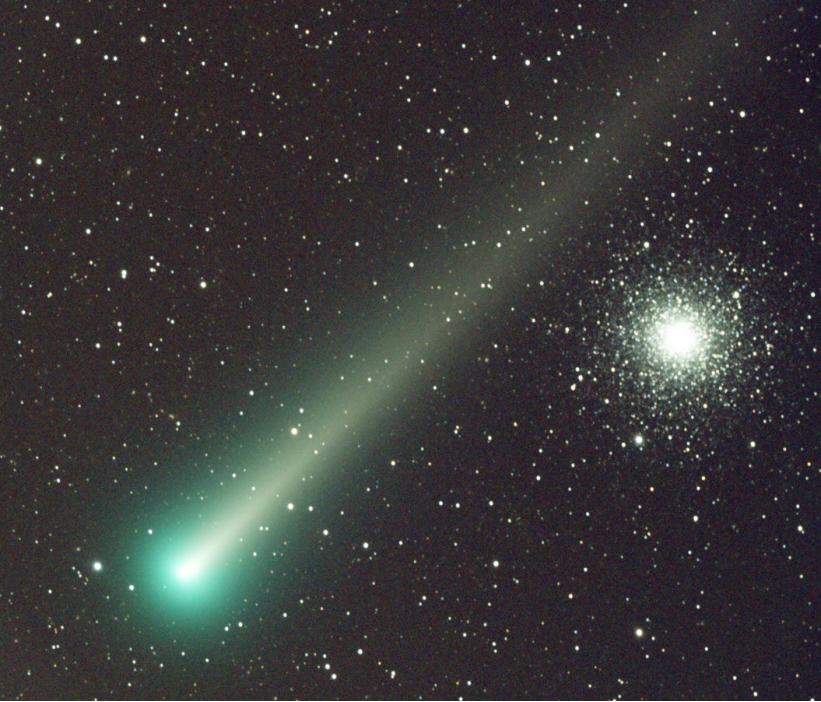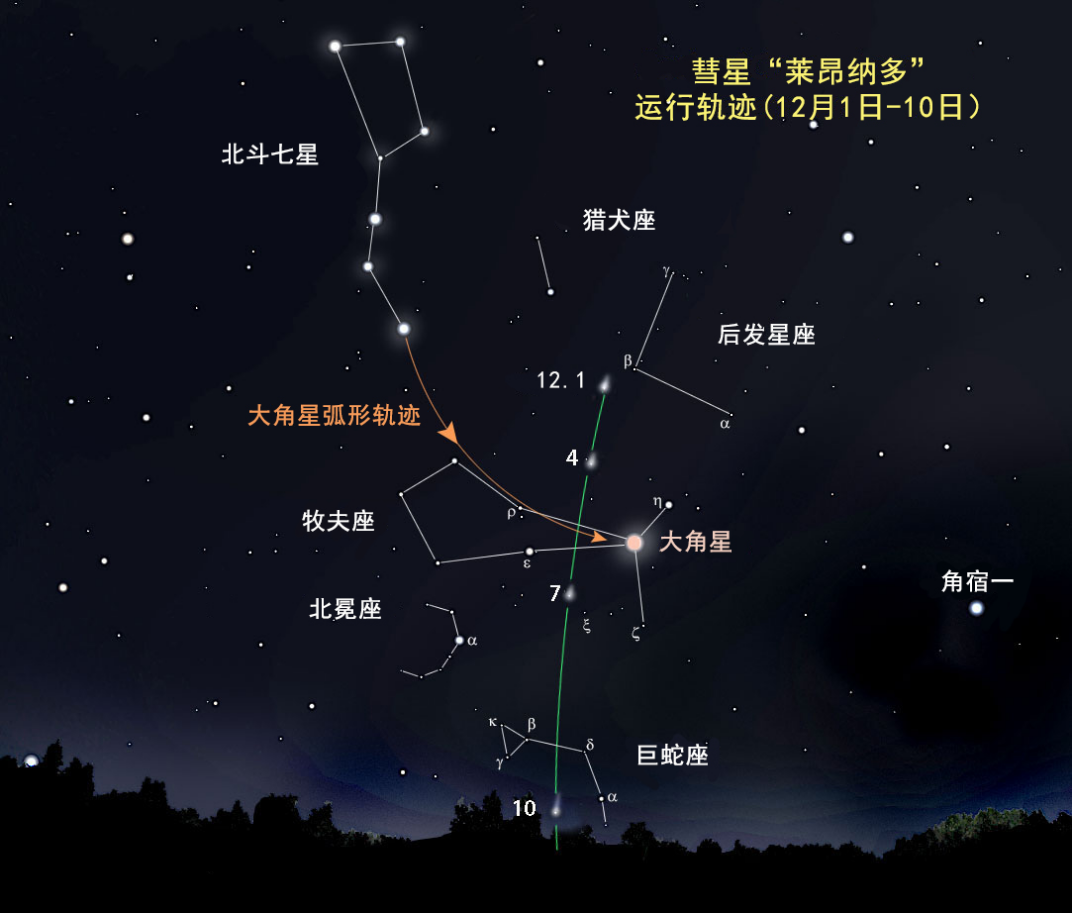See Comet Leonard at Its Best
“年度最亮彗星奖”花落谁家?“小李子”一举夺魁!
翻译:郑修肸
校对:方照阳
编排:李云舒
后台:周子博 秦绍坤 蒿如苹
原文链接:
https://skyandtelescope.org/observing/celestial-objects-to-watch/comets/see-comet-leonard-at-its-best/
The year’s brightest comet is now on display in the pre-dawn sky this week and next. Here’s how to find it.
今年最亮的彗星“莱昂纳多”将在本周和下周的黎明前的天空中粉墨登场。狗仔队们,准备好了吗?

Comet Leonard makes a spectacular pairing with the bright globular cluster M3 in the constellation Canes Venatici on December 3, 2021.
Martin Mobberley
2021年12月3日,彗星“莱昂纳多”在猎犬座与明亮的球状星团M3交相辉映
Go out the next clear night or you might miss it! Northern Hemisphere skywatchers have a limited window in which to view Comet Leonard (C/2021 A1), which will likely become the brightest comet of the year. The good news is that while time is short, Leonard is expected to reach peak brightness during the next two weeks. Currently a binocular object around magnitude 7, the comet could become as bright as 5th magnitude as it travels eastward across Boötes, Serpens, and Ophiuchus in the predawn sky.
在下一个晴朗的夜晚出去,否则你可能会错过它!北半球的天文观测者只有限的视角观测很可能成为今年最明亮的彗星——“莱昂纳德”。好消息是,虽然时间很短,但“莱昂纳多”有望在未来两周内达到亮度峰值。这颗彗星目前是一颗视星等7等左右的天体,当黎明划破天空之时它将自西向东穿过牧夫座、巨蛇座和蛇夫座时,可能会达到5等。

Comet Leonard's orbit takes it out to the Oort Cloud, a roughly spherical repository of billions of comets that orbits the Sun out to nearly a quarter the distance to the Alpha Centauri star system. Leonard has traveled about 3,500 a.u. for a brief spin around the inner solar system before returning to this frozen fastness. Its position is shown for December 12th, when it comes closest to the Earth.
NASA, JPL Horizons
“莱昂纳多”的轨道延伸到奥尔特云——这是一个囊括几十亿颗彗星的近球形宝地,它围绕太阳运行,比太阳距离半人马座α恒星系统近四分之一的距离。在“莱昂纳多”回到这片极寒之地之前,它已经在内太阳系旅行了3500AU(注:AU为天文单位,为地球到太阳的平均距离)。它在12月12日时离地球最近。图源:NASA, JPL Horizons
Senior research specialist Greg Leonard at the Mt. Lemmon Observatory near Tucson, Arizona, discovered the comet on January 3, 2021, when it was little more than a faint, distant speck. Since then, it's inched steadily closer to both the Sun and Earth and will reach perihelion — closest approach to the Sun — on January 3, 2022. Three weeks prior, on December 12th, it will pass nearest the Earth at a distance of 21.7 million miles (34.9 million km).
勒蒙天文台(位于亚利桑那州图森市附近)的高级研究专家格雷格·莱昂纳多在2021年1月3日发现了这颗彗星,当时它只不过是一个微弱而又遥远的小斑点。从那时起,它逐渐接近太阳和地球,并将于2022年1月3日到达近日点。12月12日时,它将经过距离地球最近的地方(3490万千米)。
While Comet Leonard won't compare to the splendor of last July's Comet NEOWISE, it's likely to become faintly visible with the unaided eye from a dark sky within a few days of December 12th. That also happens to be the the date, give or take, that it will succumb to the glare of morning twilight low in the eastern sky. You'll see it best with a pair of binoculars or a telescope from locations with a dark eastern sky. Use this light pollution map to help you locate the best spot in your city or region. Fortunately, the Moon will be around new phase and not a concern.
虽然“莱昂纳多”无法与去年7月的“尼奥威斯”相提并论,但在12月12日的几天内,仅仅用肉眼也能在黑暗的天空中隐约看见它的身躯。当然,如果要想更为清晰看见它,最好面向东方,用一副双筒望远镜或一台望远镜就能在黑暗的天空中看到它。尽管现在光污染较为严重,使用这张地图也可以帮助你在你所在城市或地区找到观测它的最佳地点。老天保佑,这时月亮还是“新月”,因此不会对观测产生什么影响。

Comet Leonard crosses through Boötes and Serpens in the upcoming week. Stars are shown to about magnitude 6.
Stellarium with additions by Bob King
“莱昂纳多”在接下来的一周将穿过牧夫座和巨蛇座。图中的恒星此时大致是6等
What will we see? Comets can be tricky to predict because they have a penchant for unpredictability. Composed of fragile honeycombs of ices both exotic and familiar, they sometimes break apart when nearing the Sun. Solar heating vaporizes the ice, creating pressures within and without the comet's body that can sometimes disrupt it, tearing it apart.
那么我们能看到什么呢?彗星由蜂巢状冰组成,当彗星接近太阳时,太阳散发的热量使冰蒸发,在彗星内部和外部产生压力而逐渐撕裂解体,因此本身很脆弱而难以被预测到。
It's even possible that something of the sort is happening right now with Leonard — after steadily brightening, it has recently shown signs of plateauing. Assuming its nucleus hangs together, binoculars should reveal the coma as a soft patch of light, brighter toward the center, about half the Moon's apparent diameter. With averted vision you may glimpse a degree or more of faint tail pointing upward to the northwest.
“莱昂纳多”也很可能正步“前辈”之后尘——最近,在逐渐变亮之后,它已经趋于稳定。现在,让我们假设彗核是连在一起的,通过双筒望远镜,彗差(注:光轴外的某一物点向镜头发出一束平行光线,经光学系统后,在像平面上会形成不对称的弥散光斑,这种弥散光斑的形状呈彗星形,故称作彗差)的边缘应该会较为柔和,其亮度越到中心更亮,直径约为月球的一半。这时看向旁边,你可能会看见直向西北方向的彗尾。
Keep a close eye on Leonard on as many mornings as possible. Should the nucleus break apart due to solar heating or other forces, it could experience a modest outburst and then fade rapidly. Contrariwise, forward scattering from cometary dust, as discussed in this previous article, could temporarily pump up its brightness and guarantee a naked-eye view. We wait with bated lens and telescopes to see what Leonard's next move will be.
尽量在早晨密切关注莱纳德吧!没准再过几天,它便葬身火海——如果原子核由于太阳释放强大的热能或其他力量而分裂,这颗彗星可能会轻微爆发,继而迅速消失。另一方面,彗星尘埃的前向散射可以暂时提高其亮度,并保证肉眼可见。——不过这也可能是它生命最后的余晖。不管怎么说,让我们准备好望远镜吧。此时,对于“莱昂纳多”的下一步行动已是万事俱备,只欠东风。

Comet Leonard races across Serpens and into Ophiuchus during its last mornings of visibility before transitioning into evening twilight.
Stellarium with additions by Bob King
在黄昏时分来临之前,“莱昂纳多”在最后一个它能被观察的早晨相继跨过巨蛇座和蛇夫座
As the comet is now quickly approaching both the Earth and the Sun, it's speeding faster across the sky. For the next few mornings (through December 8th) you'll find it in the constellation Boötes, not far from the brilliant, orange giant Arcturus. Hold this star's hand, and you'll have an able guide to Leonard. On Saturday morning, December 4th, the comet stands 8.5° to the star's upper left and just 5° away on the 6th. Although the comet's altitude decreases each morning, this may be offset by its growing brightness. Peak magnitude around 4.5–5 is expected from about December 10th to December 15th.
由于引力平方反比关系,“莱昂纳多”离地球和太阳越近,它在天空中的速度就越快。在接下来的几天早上(直到12月8日),你会在离明亮的橙色大角星不远处的牧夫座方向发现它。有了这位天然的向导,你能够轻易发现“莱昂纳多”。12月4日星期六上午,它在牧夫座左上角的8.5°处,12月6日仅相距5°。虽然每天早晨它的高度都在下降,但它的亮度也在不断增加。12月10日至12月15日,它的视星等预计达到4.5-5等。
Staring on around December 12th, Leonard swings into the evening sky and slowly distances itself from the Sun while also fading. This is when Southern Hemisphere observers will have the best view, while dusk will likely swallow the sight for northerners. I made my last Leonard observation in 10×50 binoculars and a 15-inch telescope during the November lunar eclipse. With the moon tucked deeply in shadow at mid-eclipse, I stole views of its fluffy coma, compact "fuzzy-star" nuclear region and lovely degree-long tail.
从12月12日左右开始,“莱昂纳多”犹如夜空中起舞的精灵,慢慢地远离太阳,同时也逐渐从深处北半球的人们视野中消失。此时,南半球的观测者将拥有最好的视野,而对于北方人来说,黄昏可能会吞没视野。
As I write this, I'm on a cruise ship speeding northeast at 15 knots an hour toward the centerline of the December 4th total solar eclipse. With luck, we'll arrive under clear skies near South Georgia Island off the coast of South America and, if successful, I hope to share photos of the singular event tomorrow right here.
I mention my location and purpose because from latitude -60° south Comet Leonard is burrowed deep below my horizon. And by the time I return home it will be lost in twilight glare. I encourage all of you fortunate enough to be in the right place to take advantage of your viewing opportunities. Find a dark location and seek this dusty phantom that has finally arrived at your door after a 35,000-year pilgrimage from the outer solar system. Oh and please say "hi!" for me.
“莱昂纳多”消失在了暮色中。但我们可以找到一个黑暗的地方,抬头仰望,寻觅这个远离世俗的幽灵。当它在外太阳系进行了35000年的朝圣之旅后终于又来到了你的门前,扣响门铃。
“嗨!”——灵动的舞姿,曼妙的身形,闪烁的瞳孔,终重入你心。